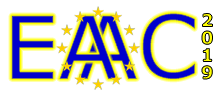Speaker
Description
Laser Plasma Accelerators (LWFAs) operating in the linear and quasi-linear regime require the driving laser pulse to be guided over the length of the accelerator stage. Multi-GeV plasma stages, for example, require the driving pulse to be guided over 100s of millimetres of plasma of density $n_\mathrm{e}(0) \approx 10^{17}~\mathrm{cm}^{−3}$. These challenging parameters can be met by hydrodynamic optical-field-ionized (HOFI) plasma channels.
In a HOFI plasma channel, OFI within a line focus generates a hot plasma column; this expands rapidly to drive a cylindrical shock wave, within which is formed a low density plasma channel. In our first demonstration of this approach the initial line focus was generated by a refractive axicon lens. Although plasma channels with the desired properties were generated, the incident intensity required to generate them was significantly higher than expected.
In this study, the effects of dispersion within the axicon on the intensity of the axicon focus are studied. The results of analytic and numerical simulations are presented; these are found to be in excellent agreement and suggest that chromatic aberrations were not significant in this case. Alternative reasons for the higher than expected threshold intensity are discussed.

